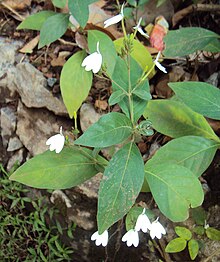Rhinacanthus nasutus
| Rhinacanthus nasutus | |
|---|---|

| |
| R. nasutus | |
| Scientific classification | |
| Kingdom: | |
| (unranked): | |
| (unranked): | |
| (unranked): | |
| Order: | |
| Family: | |
| Subfamily: | |
| Genus: | |
| Species: | R. nasutus
|
| Binomial name | |
| Rhinacanthus nasutus | |
| Synonyms | |
|
Justicia nasuta L. | |
Rhinacanthus nasutus, commonly known as snake jasmine (Hindi: कबुतर का फुल kabutar ka phul, पालक जूही; Marathi: गजकर्णी gajkarni; Sanskrit: यूथिकापर्णी yuthikaparni; Tamil: நாகமல்லீ,Nagamalli; Telugu: నాగమల్లె Nagamalle; Tagalog: tagak-tagak).[1][2]
Botanical information


Native to India, this useful plant is a slender, erect, branched, somewhat hairy shrub 1–2 m in height. The leaves are oblong, 4–10 cm in length, and narrowed and pointed at both ends. The inflorescence is a spreading, leafy, hairy panicle with the flowers usually in clusters. The calyx is green, hairy, and about 5 mm long. The corolla-tube is greenish, slender, cylindric, and about 2 cm long. The flowers is 2-lipped; the upper lip is white, erect, oblong or lancelike, 2-toothed at the apex, and about 3 mm in both length and width; and the lower lip is broadly obovate, 1.1-1.3 cm in both measurements, 3-lobed, and white, with a few, minute, brownish dots near the base. The fruit (capsule) is club-shaped and contains 4 seeds.[3]
Uses
R. nasutus has been used to treat numerous diseases such as eczema, herpes, pulmonary tuberculosis, hepatitis, diabetes, hypertension, and different types of skin diseases.[4] It is also useful in treating snake bites.[5]
Rhinacanthus nasutus is known for its antioxidant property, Research has shown that it has high potential to treat a number of neurodegenerative diseases - dementia, stroke, Huntington’s disease, Parkinson’s disease and Alzeheimer's disease.[6][7][8][9]
Rhinacanthus nasutus serves as a potential agent for controlling Aedes aegypti and Culex quinquefasciatus. [10]
Extracts of R.nasutus showed antifungal, antibacterial, antiviral, anticancer, antiinflammatory, antidiabetic and antiproliferative activities.[11][12][13][14][15][16][17]
References
- ^ D K Ved, Suma Tagadur Sureshchandra, Vijay Barve, Vijay Srinivas, Sathya Sangeetha, K. Ravikumar, Kartikeyan R., Vaibhav Kulkarni, Ajith S. Kumar , S.N. Venugopal, B. S. Somashekhar, M.V. Sumanth, Sugandhi Rani, Surekha K.V. and Nikhil Desale. 2002-2014. (envis.frlht.org / frlhtenvis.nic.in). FRLHT's ENVIS Centre on Medicinal Plants, Bangalore.
- ^ Image on Flickr https://www.flickr.com/photos/dinesh_valke/2395181283/
- ^ "Rhinacanthus nasutus - Snake Jasmine". flowersofindia.net.
- ^ Rhinacanthus nasutus Improves the Levels of Liver Carbohydrate, Protein, Glycogen, and Liver Markers in Streptozotocin-Induced Diabetic Rats, hindawi, 20 August 2013
- ^ medicinal uses pharmacographica indica
- ^ James M. Brimson. "Molecules - Free Full-Text - Rhinacanthus nasutus Protects Cultured Neuronal Cells against Hypoxia Induced Cell Death". MDPI.
- ^ Brimson, James; T. Tencomnao (26 July 2011). "Rhinacanthus nasutus Protects Cultured Neuronal Cells against Hypoxia Induced Cell Death". Molecules. 16 (8): 6322–38. doi:10.3390/molecules16086322. PMID 21792150.
{{cite journal}}: CS1 maint: unflagged free DOI (link) - ^ Brimson, James; Brimson. S; Brimson. C; Rakkhitawatthana. V; Tencomnao. T (23 April 2012). "Rhinacanthus nasutus Extracts Prevent Glutamate and Amyloid-β Neurotoxicity in HT-22 Mouse Hippocampal Cells: Possible Active Compounds Include Lupeol, Stigmasterol and β-Sitosterol". International Journal of Molecular Sciences. 13 (4): 5074–5097. doi:10.3390/ijms13045074.
{{cite journal}}: CS1 maint: unflagged free DOI (link) - ^ Brimson, James; Tewin Tencomnao (2013). "Medicinal herbs and antioxidants: potential of Rhinacanthus nasutus for disease treatment?". Phytochemistry Reviews. 13: 643–651. doi:10.1007/s11101-013-9324-2.
- ^ http://www.entomoljournal.com/vol3Issue1/pdf/53.1.pdf
- ^ Kodama, Osamu. "Isolation and Identification of an Antifungal Naphthopyran Derivative from Rhinacanthus nasutus". Journal of Natural Products. 56: 292–294. doi:10.1021/np50092a018.
- ^ Puttarak, P. "Antimicrobial activity and stability of rhinacanthins-rich Rhinacanthus nasutus extract". Phytomedicine. 17: 323–327. doi:10.1016/j.phymed.2009.08.014.
- ^ Tewtrakul S, et al. (2009). "Effects of rhinacanthins from Rhinacanthus nasutus on nitric oxide, prostaglandin E2 and tumor necrosis factor-alpha releases using RAW264.7 macrophage cells". nih.gov. 16: 581–5. doi:10.1016/j.phymed.2008.12.022. PMID 19303271.
- ^ "Induction of Apoptosis by Rhinacanthone Isolated from Rhinacanthus nasutus Roots in Human Cervical Carcinoma Cells". jst.go.jp.
- ^ http://www.hindawi.com/journals/ecam/2013/102901/
- ^ "Antiproliferative Activity of Rhinacanthus nasutus (L.) KURZ Extracts and the Active Moiety, Rhinacanthin C". jst.go.jp.
- ^ Kernan, MR; Sendl, A; Chen, JL; Jolad, SD; Blanc, P; Murphy, JT; Stoddart, CA; Nanakorn, W; Balick, MJ; Rozhon, EJ. "Two New Lignans with Activity against Influenza Virus from the Medicinal Plant Rhinacanthus nasutus". Journal of Natural Products. 60: 635–637. doi:10.1021/np960613i. PMID 9214738.
